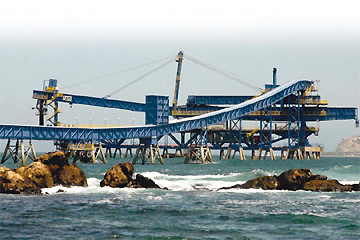In the region of Coquimbo, the areas that drive economy and which contribute the most to the national Gross Domestic Product are mining, agriculture and fishing.
The fertile soil allows for the presence of intense farming; in the last few years, the Los Pelambres mine has updated the extraction and production of copper, and fishing continues to be an important source of employment. Commerce and tourism also stand out as sources of income and work, especially along the coast.
It is also worth pointing out that in the region of Coquimbo, the industrial sector is directly related to the primary activities that take place in this area.
It is mainly concentrated in the frozen and packed process plants for fish and seafood, the pisco industry and preserves involving papayas and dehydrated fruit.
Mining
It is the region’s main economic activity. Geographically, the deposits found between the Los Choros gully and the Elqui river contain important reserves of copper, iron, manganese, kaolin, silver and gold.
Farther south, between the Elqui and Limari rivers, copper, limestone, quartz, manganese and lead are exploited; finally, between the Limari and Choapa rivers, there is silver, mercury, copper, zinc, lead, quartz and limestone.
The boost minig has experienced in the last few decades has also enabled the development of new related activities. This is how companies have sprung up that supply consumables and mining equipment and metal-mechanical solutions. Commerce and transportation have also received a boost.
The most important deposit is Los Pelambres. Located in the Andean ranges of the province of Choapa, it contains considerable copper reserves, which even place it among the 10 most important copper deposits in the world.
Located at over 3,000 masl, its annual production is 330,000 tons of fine copper and nearly 9,000 tons of molybdenum.
Another stand out is the El Indio gold deposit, which generates nearly 60% of the national production of this mineral, as well as El Romeral, located near La Serena, where iron is extracted.
Agriculture
The climate, soil and irrigation conditions present allow for the development of important farming activities in the Elqui, Limari and Choapa valleys.
The presence of the rivers that bear the same names is without a doubt a determining factor for the existence of diverse crops, especially fruits and vegetables.
We have to mention that the reason this is second most important activity in the region (after mining) are the technological breakthroughs applied to the area, such as the construction of reservoirs, roads, irrigation canals, agro-industrial facilities and transportation systems that improve this economic activity.
The region’s most intensive agriculture takes place in the Elqui valley. There are numerous terraces of fertile soil there, where they grow products like papayas, chirimoyas, lucumas and avocadoes.
Further inland, the terraces disappear and floodplains and crops grown on the valley slopes begin. The sector is filled with grapevines that are mainly aimed at pisco production. There is also an associated production of raisins.
In the Limari and Choapa river valleys, subtropical crops are produced according to the flow of the rivers; upstream, tomatoes, garlic, lettuce and grapevines standout. Their main market is the center of the country.
Fishing and forestry sector
This sector is one of the ones that contributes the most to the development of the regional economy and it also constitutes an important source of employment.
Small-scale fishing mainly catches, locos (a mussel), clams, lapas, oysters and crabs, in addition to fish, such as anchovies, Atlantic mackerels, Inca scads, hakes and conger fish.
Thanks to this extraction of marine resources, there is also a fishing industry aimed at the elaboration of preserves and frozen products.
Regarding the forestry activity, the province of Choapa concentrates a sizeable portion of the surfaces of mixed forest (native and forestry) and forestry plantations for the region of Coquimbo.
Out of the total area devoted to silviculture, 20.6 hectares are located in the comuna (county) of Illapel and 1,819.3 are in the comuna of Los Vilos.
Regional exports
According to numbers provided by ProChile, between January and September of 2007, there was an increase in copper exports, which reached over 1,860 million dollars.
In addition, the region also trades products abroad, like grapes, avocadoes, mollusk preserves and clementines, among others. The main markets are Japan, China and the United States.
It is important to point out that the traffic and commercialization of products are benefited from an important road and port system.
Starting in La Serena, route 5 North has two way traffic all the way to Puerto Montt, and many of the local routes merge onto it. Meanwhile, the region has three ports. Guayacan is where the iron production is loaded onto the ships.
It began operations in 1955 and it is a mechanized terminal that belongs to the Compañia Minera del Pacifico (Pacific Mining Company). The port of Coquimbo has two docking stations, with a total length of 378 meters. It even has the necessary capacity to implement new front ends.
Finally, in the bay of Conchali, near Los Vilos, there is Punta Chungo port, which is mainly used to ship copper concentrate produced at the Los Pelambres mine.
There is also a significant airport infrastructure in the region, which is made up by the La Florida airport, near the city of La Serena, along with a network of approximately 17 airstrips.








 Muere Evita
Muere Evita